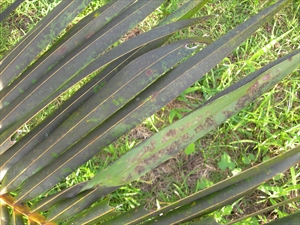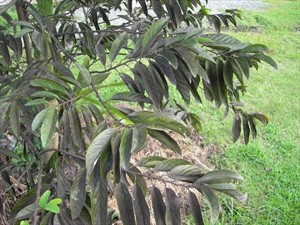Sooty moulds
Pacific Pests, Pathogens, Weeds & Pesticides - Online edition
Pacific Pests, Pathogens, Weeds & Pesticides
Sooty moulds (051)
A number of sooty mould fungi have been identified in Pacific island countries; e.g., those from Solomon Islands - mostly from living leaves - are as follows: Aithaloderma citri (grapefruit); Capnodium citri (citrus); Capnodium mangiferum (mango); Capnodium sp. (papaya); Chaetasbolisia microglobulosa (chilli); Chaetothyrium setosum (coconut, Xanthosoma taro); Limacinula samoenesis (coconut); Microxiphium spp. (chilli, coconut, oil palm); Trichomerium spp. (coconut, oil palm); Tripospermum fructigenum (Pometia pinnata); Tripospermum gardneri (oil palm, cocoa); Tripospermum sp. (chilli); Triosporiopsis sp. (papaya). Many of these species and others are present in Fiji, Samoa and Tonga.
Other fungal genera recorded in these countries and elsewhere are: Antennulariella, Parascorias and Scoria species.
Worldwide in the sub-tropics and tropics. Sooty moulds are recorded from Australia, American Samoa, Cook Islands, Fiji, Federated States of Micronesia, Kiribati, Marshall Islands, Niue, Papua New Guinea, Samoa, Solomon Islands, Tonga, Tuvalu, and Vanuatu, and are most likely present in all countries of Oceania.
Many plants develop sooty moulds when colonised by insects that produce honeydew, e.g., coconut, guava, mango, soursop and ornamentals, e.g., Frangipani.
There are many fungal species, mostly saprophytes (i.e., non-pathogens) that form sooty mould deposits on trees and shrubs, interfering with the normal function of leaves. Often, their presence is a sign that sap-sucking insects are present (Photo 1). Large populations of insects mean large amounts of honeydew, and dense growths of sooty mould fungi over leaves and stems (Photos 1-4). Often, insect populations increase rapidly, and remain a long time, especially when ants protect them from their natural predators and parasites.
Sooty moulds do not attack plants. The fungi that cause sooty moulds grow on the sugary substances that are produced by insects - mostly, aphids, soft scale (not armoured scale), leafhoppers, planthoppers, psyllids and whiteflies - as they suck the sap of plants. The secretions are known as 'honeydew'.
The fungi that grow on honeydew reduce the plants ability to photosynthesise and this may stunt growth, cause leaves to yellow and die early, and may reduce the quality of fruit.
Look for sooty mould on new growth and leaves, since the insects associated with sooty moulds prefer soft tissues.
All the methods used for treating sooty mould are aimed at controlling the insects that secrete the honeydew. Without honeydew, it is unlikely that there would be sooty mould. However, the insects may be protected from their natural predators and parasites by ants, so removing ants should be the first priority, if they are present.
CULTURAL CONTROL
- If ants are present and ground-nesting, kill them with boiling water, if it is possible to do that without damaging the crop plants. Without the ants, predators and parasites will bring about natural control (other methods of ant control are given below).
- Prune low-hanging branches of trees and shrubs, and remove weeds, to stop ants reaching the sap-sucking insects.
CHEMICAL CONTROL
- Use soap sprays (5 tablespoons of pure hand soap in 4 L water or 2 tablespoons of dish-washing liquid in 4 L water), or use commercial white oil (petroleum oil) to kill the sap-sucking insects. These sprays work by blocking the breathing holes of insects causing suffocation and death. Spray the undersides of leaves; the oils must contact the insects.
- Use homemade oil spray by mixing together, 1 cup cooking oil, 2 cups water, 1 teaspoon dishwashing liquid. Dilute the mixture at the rate of 3 teaspoons per half a litre of water and spray on the infested leaves. The addition of malathion is useful against scales insects.
- Use synthetic pyrethroid insecticides to kill ants; these insecticides may also be tried against scale insects as they are likely to be effective against the crawlers - crawlers are the active nymphs which spread infestations to new plants and/or new gardens.
____________________
When using a pesticide (or biopesticide), always wear protective clothing and follow the instructions on the product label, such as dosage, timing of application, and pre-harvest interval. Recommendations will vary with the crop and system of cultivation. Expert advice on the most appropriate pesticide to use should always be sought from local agricultural authorities.
AUTHORS Helen Tsatsia & Grahame Jackson
Information from RHS (undated) Sooty moulds. Royal Horticultural Society. UK. (https://www.rhs.org.uk/advice/profile?pid=770); and from Sooty mold. Wikipedia. (https://en.wikipedia.org/wiki/Sooty_mold); Gillman D (2011) Sooty Mold. The Center for Agriculture, Food and the Environment. University of Massachusetts Amherst. (https://ag.umass.edu/landscape/fact-sheets/sooty-mold). Photo 3&4 Kohler F, et al. (1997) Diseases of cultivated crops in Pacific Island countries. South Pacific Commission. Pirie Printers Pty Limited, Canberra, Australia.
Produced with support from the Australian Centre for International Agricultural Research under project PC/2010/090: Strengthening integrated crop management research in the Pacific Islands in support of sustainable intensification of high-value crop production, implemented by the University of Queensland and the Secretariat of the Pacific Community.







